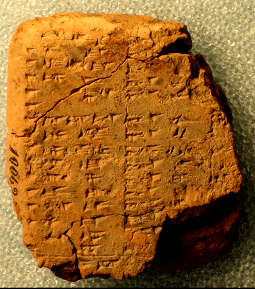Introduction to Syllabary B
Syllabary B (a modern designation, abbreviated Sb) was a two-chapter list first introduced in the latter half of the second millennium. Sb is an abbreviated version of the list Ea. Whereas Ea (and the related list Aa) give multiple readings and translations for individual signs, Sb usually gives only a single reading and translation for each sign.
Sb follows the same format as most other sign lists, with the same data types: pronunciation gloss, sign form, and (Akkadian) translation. The majority of exemplars, however, omit the pronunciation gloss and/or the translation. Only rare library copes and late first millennium exercises preserve the full format.

VAT 10062 (reverse), a Middle Assyrian example of Sb.
Sb was used as an elementary school exercise in the first millennium, introduced immediately after Syllabary A. These exercises often include short extracts from Sb as well as extracts from other lists or literary texts. This exercise format provides the majority of our extant exemplars (about 300).
Despite its status as an elementary exercise, Sb includes some complicated sign form, rare signs, and uncommon sign values.
Sb follows the basic order of signs given in Ea. This structure occasionally displays associations between signs and sections of signs. The short ŠA section in Sb II (59-60) follows the ŠA₃ section (53-58) based on the phonetic similarity between the readings ša (for ŠA) and ša₃ (for ŠA₃). The ŠA₃ section likely follows the section with fractions and the sign UDUG based on the graphic similarity of these signs.
27 Dec 2019C. Jay Crisostomo
C. Jay Crisostomo, 'Introduction to Syllabary B', Digital Corpus of Cuneiform Lexical Texts: Sign Lists, The DCCLT Project, 2019 [http://oracc.museum.upenn.edu/dcclt/signlists/signlists/syllabaryb/]
